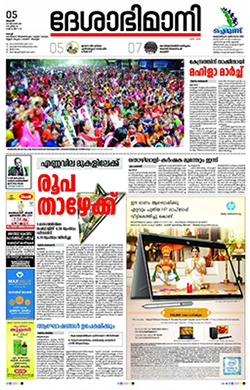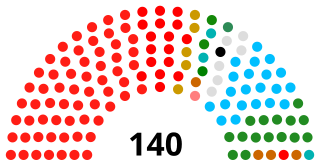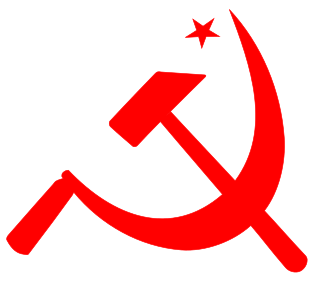This article contains weasel words: vague phrasing that often accompanies biased or unverifiable information.(September 2016) |
Olivukala Smrithikal-.
Nayanar had been a correspondent and editor for Deshabhimani. He had worked in Chennai as Deshabhimani correspondent. He used to write a weekly column in Deshabhimani, Munnottu (Forward). [6] [18]
In popular culture
Nayanar was renowned for his humorous remarks and speeches. [3] During his third term as Chief Minister, Nayanar also used to conduct a public interaction show, "Mukhya Mantriyodu Chothikyuka" ("Ask the Chief Minister") in Asianet TV channel. [19] [20]
Personal life
Nayanar married Sarada Teacher, niece of K. P. R. Gopalan in 1958. They had two sons and two daughters. [3] [4]
Death

Nayanar was admitted to the AIIMS on 26 April for advanced treatment of diabetes, from which he suffered for a long time, after a brief stay at the Medical College Hospital in Thiruvananthapuram earlier. His condition became worse following a massive heart attack, which was his third, on 6 May when he was put on the life support system. He died on 19 May 2004 at the age of 85 after suffering from heart and kidney failure. [2] He was cremated with full state honours at Payyambalam Beach, Kannur. He is survived by his wife, children, in-laws and grandchildren.
See also
Related Research Articles

Kannoth Karunakaran was an Indian politician who served as the chief minister of Kerala in 1977, from 1981 to March 1982, from May 1982 to 1987 and from 1991 to 1995. He is the founder of the Indian National Congress (INC)-led United Democratic Front (UDF) coalition, which governed the state in the periods of 1982-87, 1991-96, 2001-06 and 2011-16; and currently is the main opposition in Kerala since 2016. He has also served as the Union Minister of Industry from 1995 to 1996 and served as the Leader of the Opposition in the Kerala Legislative Assembly for four terms- 1967 to 1969, 1978 to 1979, 1980 to 1981 and 1987 to 1991. He also has the distinction of being one of the longest serving Congress Legislature Party (CLP) Leaders in the country, holding that post from 1967 to 1995.

The Left Democratic Front (LDF) is an alliance of left-wing political parties led by Communist Party of India (Marxist) in the Indian state of Kerala. It is the current ruling political alliance of Kerala, since 2016. It is one of the two major political alliances in Kerala, the other being Indian National Congress-led United Democratic Front, each of which has been in power alternately for the last four decades. LDF has won the elections to the State Legislature of Kerala in the years 1980, 1987, 1996, 2006, 2016 and had a historic re-election in 2021 where an incumbent government was re-elected for first time in 40 years. LDF has won 6 out of 10 elections since the formation of the alliance in 1980. The alliance consists of CPI(M), CPI and various smaller parties.

Velikkakathu Sankaran Achuthanandan, popularly known by his initials V. S., is an Indian politician who was the Chief Minister of Kerala from 2006 to 2011. At 82, he was the oldest person to have assumed the office. He is affiliated to the Communist Party of India (Marxist). He served as the chairman of Administrative reforms in Kerala with state cabinet rank from 2016 to 2021. He has served as Leader of the Opposition for 15 years which makes him the longest serving Leader of the Opposition in Kerala Legislative Assembly.

Oommen Chandy was the 10th chief minister of Kerala, serving from 2004 to 2006 and 2011 to 2016. He served also as the leader of the opposition in the Kerala Legislative Assembly from 2006 to 2011.
Kunnathu Puthiyaveettil Ramapurathu Gopalan, popularly known as KPR was an Indian politician and a communist leader from Kalliasseri, Kerala. Once a member of the Kerala State Assembly, he lost his seat in the general election of 1 February 1960. He was subsequently re-elected. While a member, he led a failed attempt at armed revolt in the Cannanore area. At one point he was sentenced to death by the colonial authorities, before the sentence was commuted by Charu Chandra Biswas, at the urging of A. K. Gopalan.

Deshabhimani is a Malayalam newspaper and the organ of the Kerala State Committee of the CPI(M). It started as a weekly in Kozhikode on 6 September 1942 and converted to a daily in 1946. The paper now has ten different printing centres: Kozhikode, Kochi, Thiruvananthapuram, Kannur, Kottayam, Thrissur, Palakkad, Alappuzha, Kollam and Malappuram. At present, Puthalath Dinesan State Secretariat Member of the CPI(M) is the Chief Editor of the paper, K.J. Thomas, CPI(M), secretariat member of the CPI(M), the General Manager and V. B Parameshwaran, the Resident Editor.

The United Democratic Front (UDF) is the Indian National Congress-led alliance of centre to centre-right political parties in the Indian state of Kerala. It is one of the two major political alliances in Kerala, the other being Communist Party of India (Marxist)-led Left Democratic Front, each of which has been in power alternately since 1980 E. K. Nayanar ministry. Most of the United Democratic Front constituents are members of the Indian National Congress-led Indian National Developmental Inclusive Alliance at pan-India level.

Pinarayi Vijayan is an Indian politician who serves as the Chief Minister of Kerala since 25 May 2016. A member of the politburo of the Communist Party of India (Marxist), he is the longest-serving secretary of the Kerala State Committee of the CPI(M) (1998–2015). He has also served as Minister of Electric Power and Co-operatives during the third E. K. Nayanar ministry. Vijayan won a seat in the May 2016 Kerala Legislative Assembly election and 2021 Kerala Legislative Assembly election as the CPI(M) candidate for Dharmadom constituency and was selected as the leader of the Left Democratic Front (LDF) and became the 12th Chief Minister of Kerala. He is the first chief minister from Kerala to be re-elected after completing a full term in office. In 2022, he also became the longest-continuous serving chief minister of Kerala surpassing C. Achutha Menon who had been the first to remain in office for 2364 consecutive days.
Lonappan Nambadan was an Indian politician from Kerala. He was member of the Kerala Legislative Assembly for six terms from 1977 - 2001 and was a state minister in two E. K. Nayanar ministries. He was a member of the 14th Lok Sabha of India. He represented the Mukundapuram constituency of Kerala and was a member of the Communist Party of India (Marxist) political party.
Susheela Gopalan was an Indian Communist leader and one of the founding members of the Communist Party of India (Marxist).
Melathu Veettil Raghavan was a veteran Communist leader and a former Minister in Kerala state of India. He was the General Secretary of the Communist Marxist Party, an alliance partner in the UDF. Prior to the formation of the CMP he was a prominent leader of the Communist Party of India (Marxist).

The thirteenth Kerala legislative assembly election was held on 13 April 2011 to elect members representing 140 constituencies in Kerala. Election results were released on 13 May 2011. The election, whose results were released on 13 May 2011, proved to be one of the closest ones in Kerala's history, with the United Democratic Front (UDF) beating the Left Democratic Front (LDF) by a margin of 4 seats.

The United Democratic Front government led by Oommen Chandy sworn in on 18 May 2011. Seven of the total 20 members of the Cabinet took office on 18 May and the rest sworn in on 23 May after completing discussion with member parties of the UDF.

M. V. Govindan, popularly known as Govindan Master, is an Indian politician from the Communist Party of India (Marxist), and is the current Kerala State Secretary and the party's Politburo member since 2022. He previously served as the State Minister for Local self-governments and Excise in the Second Vijayan Ministry from 2021 to 2022.

Kerala's major political parties are aligned under two coalitions, namely the Left Democratic Front (LDF) and the United Democratic Front (UDF) since the late 1970s. Kerala was the first Indian state to have coalition government as early as 1961 .

Elections were held on 1980 January 3 and 5 to elect members to the sixth Niyamasabha. This election saw the formation of two pre-poll alliances, viz. LDF and UDF, most of whose constituent parties were part of the erstwhile United Front. CPI(M)-led LDF to win the election, after winning 93 seats altogether. E. K. Nayanar was sworn in as the Chief Minister on 26 March 1980

The 2021 Kerala Legislative Assembly election was held in Kerala on 6 April 2021 to elect 140 members to the 15th Kerala Legislative Assembly. The results were declared on 2 May.
Elections to local bodies in Kerala were held in December 2020. Polling took place over 3 days; on 8, 10 and 14 December, with the votes counted and results announced on 16 December.

The Communist Party of India (Marxist), Kerala or CPI(M) Kerala is the Kerala state wing of CPIM. It is responsible for organizing and coordinating the party's activities and campaigns within the state, as well as selecting candidates for local, state, and national elections. Currently, it is the governing party in the Kerala Legislative Assembly and has significant representation of the state in Rajya Sabha. The CPIM currently leads the LDF alliance.

The 1980 Parliamentary Election was a mid-term election held following the collapse of the Janata Party led governments led by Prime Ministers Morarji Desai and Charan Singh. It was also the first election that the Indian National Congress fought from the opposition. The party had suffered a split, with the faction led by former Prime Minister Indira Gandhi asserting its electoral popularity by winning 353 seats and forming a majority government of its own..
References
- 1 2 3 "Comrade E K Nayanar". People's Democracy. Archived from the original on 11 December 2004. Retrieved 23 September 2004.
- 1 2 3 4 "The people's leader". The Hindu. Archived from the original on 17 October 2012. Retrieved 19 January 2012.
- 1 2 3 4 5 "Chief Ministers and Leaders of Opposition of Kerala" (PDF). Secretariat of the Kerala legislature.
- 1 2 3 "Nayanarude Jeevitham". OneIndia. 17 May 2001. Retrieved 19 January 2012.
- ↑ "History of Kerala legislature - Government of Kerala, India". kerala.gov.in. Archived from the original on 14 August 2020. Retrieved 26 May 2019.
- 1 2 3 "Nayanar: Crowd puller of Lefitst forces". The Times of India . 19 May 2004. Archived from the original on 3 January 2013. Retrieved 19 January 2012.
- ↑ "History of Kerala legislature - Government of Kerala, India". kerala.gov.in. Archived from the original on 14 August 2020. Retrieved 12 April 2019.
- ↑ Radhakrishnan, M. G. (31 May 1996). "Elections 1996: Marxists-led LDF dislodges Congress(I) and its allies". India Today. Retrieved 12 April 2019.
- ↑ "Technopark, India's first & largest IT park, celebrates 30th anniversary". Manorama . 30 July 2020. Retrieved 29 August 2022.
- ↑ "Kudumbashree - The world's largest Women's network" (PDF). Kudumbashree Mission. Archived from the original (PDF) on 7 November 2020. Retrieved 2 November 2020.
- ↑ "About CIAL A Brief History". Manorama . 30 July 2020. Retrieved 30 July 2020.
- ↑ "Kerala becomes first Indian state to have four international airports". Livemint . 9 December 2018. Retrieved 29 August 2022.
- ↑ "Narendra Modi flags off Kochi Metro, takes maiden ride". Mint . 17 June 2017. Retrieved 22 July 2017.
- ↑ Darade, Pooja (16 June 2017). "Kochi Metro to be inaugurated by PM Modi on Saturday: Interesting facts about Kerala's first metro service". India.com. Archived from the original on 16 June 2017. Retrieved 16 June 2017.
- ↑ "Kochi Metro Railway: RITES will conduct study". Malayala Manorama . Kerala. 22 July 1999. Retrieved 16 June 2017.
- ↑ "Details of the Studies/Detailed Project Report/Comprehensive mobility planundertaken under the scheme of UT planning" (PDF). Ministry of Urban Development. Archived from the original (PDF) on 16 June 2017. Retrieved 16 June 2017.
- ↑ Sudhi, K.S. (13 July 2003). "Konkan Railway misleading Kerala on sky bus project". The Hindu . Kerala. Archived from the original on 16 June 2017. Retrieved 16 June 2017.
- ↑ "Vajpayee, Jinnah are two sides of the same coin: Nayanar". Rediff. Retrieved 19 January 2012.
- ↑ "Facing the arc lights". The Hindu . 11 July 2007. Archived from the original on 6 October 2008.
- ↑ "Ask the Chief Minister!". Rediff.
Further reading
- Chief Ministers, Ministers, and Leaders of Opposition of Kerala (PDF), Thiruvananthapuram: Secratriat of Kerala Legislature, 2018
E. K. Nayanar | |
|---|---|
 | |
| 9th Chief Minister of Kerala |
